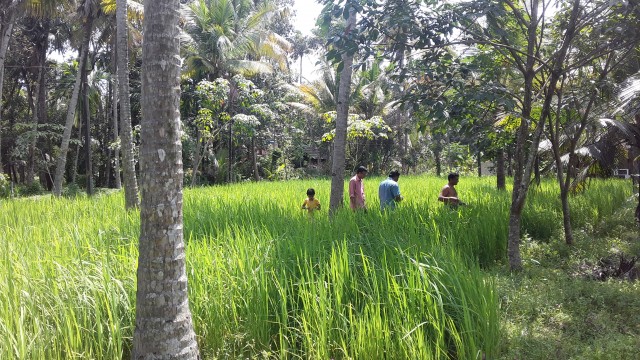Mr. Satheesh Kumar, Saraswathy Nilayam, Kannimel, Vallikunnam is a young, progressive farmer engaged in agricultural activities. He is having a coconut garden of 80 cents and paddy field of 50 cents. He grows banana as intercrop in coconut garden and sesamum. Additionally he used to cultivate paddy variety ‘Mundakan’ in his coconut garden as upland paddy during July/August to December, which is a long duration traditional variety having low productivity but for the availability of straw for rearing cattle. After the paddy crop he used to sow sesamum seeds. The major disadvantages of his crop sequence is that, if the sowing of Mundakan crop delays due to monsoon, the flowering and seed formation stage will face water scarcity and the sowing of the sesamum as a summer crop is delayed which will also be affected by drought and yield reduction. The upland paddy cultivation involves high input cost like seed, fertilizer, labour for sowing etc.
Mr. Satheesh Kumar attended a training programme organized by ICAR – Krishi Vigyan Kendra in June, 2018 in connection with the implementation of FLD programme on ‘Upland paddy cultivation using modified drum seeder’ and actively involved in the implementation of the FLD. The HYV ‘Vaishak’ released from RARS, Pattambi was sown using modified drum seeder in his 80 cent coconut garden. Scientific crop management practices were undertaken with the guidance of KVK technical staff. The Vaishak variety recorded a yield of 1485 kg/ha with a net income of Rs.45525/ha compared to the traditional practice (average yield of 485 kg/ha and Rs. 15125/ha respectively). The most significant advantage of the FLD was the requirement of seeds was only 30 kg/ha compared to 150 kg/ha for broad casting which he usually followed. The crop stand was very good and the straw yield was also high (700 kg/ha). He could get a net additional income of Rs.2720/- from his 80 cents plot.
He also participated in another FLD on ‘Scientific sesamum cultivation with moisture management’ implemented by KVK soon after the harvest of paddy. High yielding sesamum variety Thilarani released by Onattukara Regional Agricultural Research Station, Kayamkulam, suitable for the summer rice fallows of Onattukara was demonstrated in this FLD. The paddy fields were ploughed after the paddy crop and the sesamum seeds were sown @5 kg per hectare. Organic manures and fertilizers were given as per the POP recommendations. Irrigation using portable sprinklers at critical stages of the crop viz., 4-5 leaves, branching, flowering and pod formation was the highlight of the FLD. Optimum plant population was maintained by thinning. The crop was ready for harvest in 75 days.
The demonstration plots recorded a higher average yield of 438 kg/ha, compared to farmers practice (338 kg/ha). The FLD plots gave a net income of Rs.54405/ha with a BC ratio of 2.01 compared to farmers practice (Rs. 27259/ha and 1.5, respectively). Mr. Satheesh Kumar opined that, since sesamum is cultivated using the residual soil fertility and being a short duration crop is remunerative.
Cultivation of a medium duration paddy variety followed by sesamum was found to be an ideal crop sequence for Onattukara sandy soils. Paddy is cultivated as a rainfed crop and sesamum utilizes the residual moisture and nutrients. Thus the cost of cultivation could be reduced, which is a successful method for doubling farmer’s income. By integrating the ideal time of sowing of crops with scientific, cost-reducing practices, Mr. Satheesh Kumar could streamline his cropping system and obtain considerably higher income from his holding. His enthusiasm and hardworking nature makes him a model farmer replicable to the rural youth.









